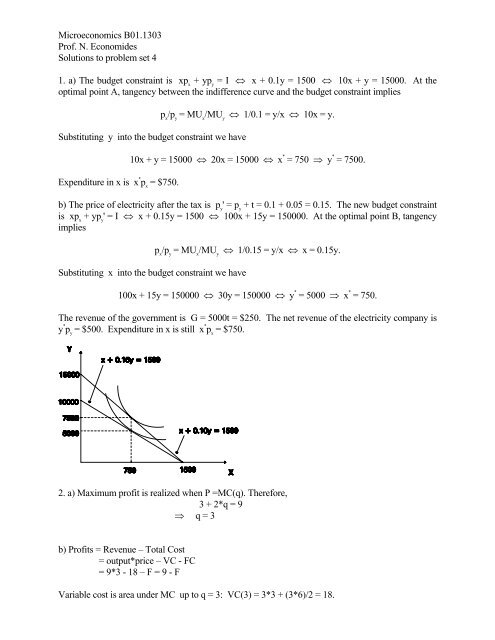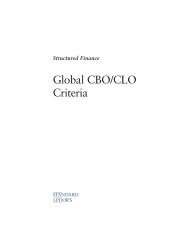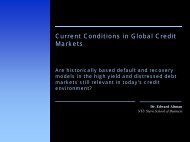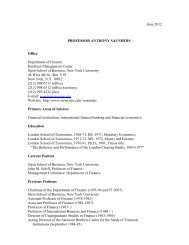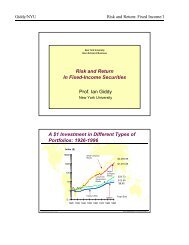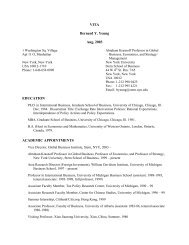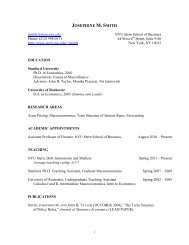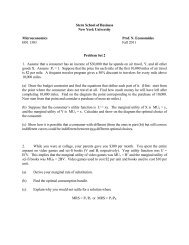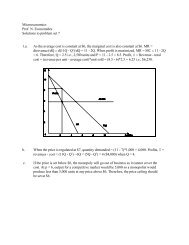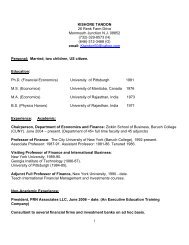Solution to problem set 4
Solution to problem set 4
Solution to problem set 4
Create successful ePaper yourself
Turn your PDF publications into a flip-book with our unique Google optimized e-Paper software.
Microeconomics B01.1303<br />
Prof. N. Economides<br />
<strong>Solution</strong>s <strong>to</strong> <strong>problem</strong> <strong>set</strong> 4<br />
1. a) The budget constraint is xp x<br />
+ yp y<br />
= I ⇔ x + 0.1y = 1500 ⇔ 10x + y = 15000. At the<br />
optimal point A, tangency between the indifference curve and the budget constraint implies<br />
Substituting y in<strong>to</strong> the budget constraint we have<br />
Expenditure in x is x * p x<br />
= $750.<br />
p x<br />
/p y<br />
= MU x<br />
/MU y<br />
⇔ 1/0.1 = y/x ⇔ 10x = y.<br />
10x + y = 15000 ⇔ 20x = 15000 ⇔ x * = 750 ⇒ y * = 7500.<br />
b) The price of electricity after the tax is p y<br />
' = p y<br />
+ t = 0.1 + 0.05 = 0.15. The new budget constraint<br />
is xp x<br />
+ yp y<br />
' = I ⇔ x + 0.15y = 1500 ⇔ 100x + 15y = 150000. At the optimal point B, tangency<br />
implies<br />
Substituting x in<strong>to</strong> the budget constraint we have<br />
p x<br />
/p y<br />
= MU x<br />
/MU y<br />
⇔ 1/0.15 = y/x ⇔ x = 0.15y.<br />
100x + 15y = 150000 ⇔ 30y = 150000 ⇔ y * = 5000 ⇒ x * = 750.<br />
The revenue of the government is G = 5000t = $250. The net revenue of the electricity company is<br />
y * p y<br />
= $500. Expenditure in x is still x * p x<br />
= $750.<br />
2. a) Maximum profit is realized when P =MC(q). Therefore,<br />
3 + 2*q = 9<br />
⇒ q = 3<br />
b) Profits = Revenue – Total Cost<br />
= output*price – VC - FC<br />
= 9*3 - 18 – F = 9 - F<br />
Variable cost is area under MC up <strong>to</strong> q = 3: VC(3) = 3*3 + (3*6)/2 = 18.
We don’t have enough information on how large is the fixed cost, so we assume it is F.<br />
Price, MC(q)<br />
27<br />
24<br />
21<br />
18<br />
MC(q) = 3 + 2q<br />
15<br />
12<br />
9<br />
Profits = 9<br />
P = 9<br />
6<br />
3<br />
Variable Cost = 18<br />
0<br />
0 1 2 3 4 5 6 7 8 9 10<br />
Output<br />
3.<br />
a) TC = Q 2 + 100, MC = 2Q, AVC = Q, ATC = Q + 100/Q.<br />
b) Short run supply curve is equal <strong>to</strong> MC for all prices because MC is greater than AVC for all<br />
prices. Long run supply curve is equal <strong>to</strong> MC for all prices above $20. This is the price at which<br />
MC>ATC. See graph. For all prices below $20, the long run supply curve will be along the Y-axis<br />
(no wheat will be supplied).<br />
c) P = MR = MC<br />
25 = 2Q ⇒ Q = 12.5<br />
Profit = P*Q - TC = 25*12.5 - 12.5 2 - 100 = 56.25<br />
d) TC = 25Q, MC = 25, AVC = 25, ATC = 25
For prices < $25, the farmer will not supply anything <strong>to</strong> the market because he will lose<br />
money in the short and long run.<br />
For prices > $25, he will supply as much as he possibly can because he makes a profit on<br />
each unit he supplies.<br />
e) He will use the new technology for all prices above $25. For all prices above $25, he can make an<br />
“infinite” profit under the new technology. For prices below $20 he would choose not <strong>to</strong> supply any<br />
wheat. For prices between $20 and $25, he would lose money with the new technology and make<br />
money with the old; therefore for these prices he will use the old technology.


